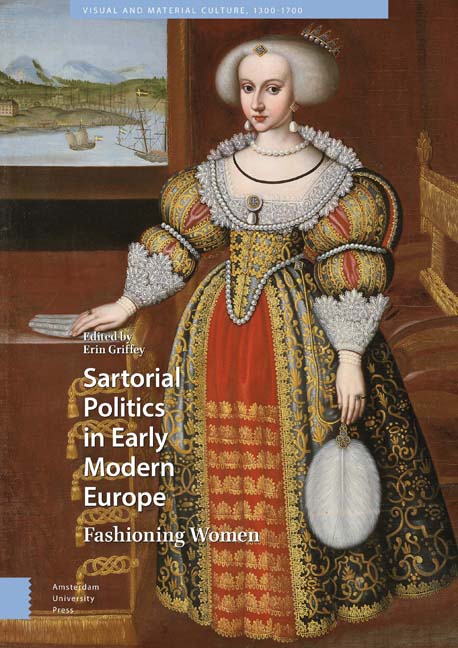Book contents
- Frontmatter
- Acknowledgements
- Contents
- List of Illustrations
- Introduction
- 1 Isabella d’Este's Sartorial Politics
- 2 Dressing the Queen at the French Renaissance Court: Sartorial Politics
- 3 Dressing the Bride: Weddings and Fashion Practices at German Princely Courts in the Fifteenth and Sixteenth Centuries
- 4 Lustrous Virtue: Eleanor of Austria's Jewels and Gems as Composite Cultural Identity and Affective Maternal Agency
- 5 Queen Elizabeth: Studded with Costly Jewels
- 6 A ‘Cipher of A and C set on the one Syde with diamonds’: Anna of Denmark's Jewellery and the Politics of Dynastic Display
- 7 ‘She bears a duke's revenues on her back’: Fashioning Shakespeare's Women at Court
- 8 How to Dress a Female King: Manifestations of Gender and Power in the Wardrobe of Christina of Sweden
- 9 Clothes Make the Queen: Mariana of Austria's Style of Dress, from Archduchess to Queen Consort (1634–1665)
- 10 ‘The best of Queens, the most obedient wife’: Fashioning a Place for Catherine of Braganza as Consort to Charles II
- 11 Chintz, China, and Chocolate: The Politics of Fashion at Charles II's Court
- 12 Henrietta Maria and the Politics of Widows’ Dress at the Stuart Court
- Works Cited
- Index
8 - How to Dress a Female King: Manifestations of Gender and Power in the Wardrobe of Christina of Sweden
Published online by Cambridge University Press: 21 November 2020
- Frontmatter
- Acknowledgements
- Contents
- List of Illustrations
- Introduction
- 1 Isabella d’Este's Sartorial Politics
- 2 Dressing the Queen at the French Renaissance Court: Sartorial Politics
- 3 Dressing the Bride: Weddings and Fashion Practices at German Princely Courts in the Fifteenth and Sixteenth Centuries
- 4 Lustrous Virtue: Eleanor of Austria's Jewels and Gems as Composite Cultural Identity and Affective Maternal Agency
- 5 Queen Elizabeth: Studded with Costly Jewels
- 6 A ‘Cipher of A and C set on the one Syde with diamonds’: Anna of Denmark's Jewellery and the Politics of Dynastic Display
- 7 ‘She bears a duke's revenues on her back’: Fashioning Shakespeare's Women at Court
- 8 How to Dress a Female King: Manifestations of Gender and Power in the Wardrobe of Christina of Sweden
- 9 Clothes Make the Queen: Mariana of Austria's Style of Dress, from Archduchess to Queen Consort (1634–1665)
- 10 ‘The best of Queens, the most obedient wife’: Fashioning a Place for Catherine of Braganza as Consort to Charles II
- 11 Chintz, China, and Chocolate: The Politics of Fashion at Charles II's Court
- 12 Henrietta Maria and the Politics of Widows’ Dress at the Stuart Court
- Works Cited
- Index
Summary
Abstract
Christina Vasa (1626–1689) was crowned King of Sweden in the middle of the seventeenth century, an era in which sartorial politics and manifestations of power in clothing were a part of life. This article deals with the importance of clothes for Christina of Sweden and her strategies to present herself in a manner that legitimized her as a sole regent, in the context of gender and royal power and seen through the accounts of the Royal Wardrobe. By systematising and analysing the content of these accounts, it becomes apparent that Christina used her clothes to create a royal persona that had a given place on the royal scene, not only in a Swedish context but also in a European one.
Key words: Christina Queen of Sweden; sartorial politics; the Swedish court; the Royal Wardrobe; gender; dress history
Christina Vasa of Sweden was crowned with the official title King of Sweden on 20 October 1650, after already having ruled as monarch for six years. At her coronation, she was dressed in white and silver garments and a purple cloak lined with ermine, which together connected traditional values with modern ones. The appearance and design of Christina's garments would have been instrumental for her to legitimise and assert her power despite being a woman, and to create the persona of a successful monarch of a powerful nation. They would also have been a way for her to connect herself to desirable social and cultural contexts, such as an heiress of the Vasa family line or a participant in the European court scene.
Many historians and art historians have studied Christina's life – her childhood as the only heir of the Vasa dynasty, the years between 1644–1654 when she was a reigning monarch, and the last and longest part of her life, which she spent in Rome after abdicating the throne in favour of her male cousin Karl X Gustav (1622–1660). When it comes to her clothing habits, the combined sources on Christina's clothing are contradictory. Most research conducted tends to rely on portraits and other types of written sources discussing her as a person and her clothing, such as personal and diplomatic letters.
- Type
- Chapter
- Information
- Sartorial Politics in Early Modern EuropeFashioning Women, pp. 183 - 206Publisher: Amsterdam University PressPrint publication year: 2019



